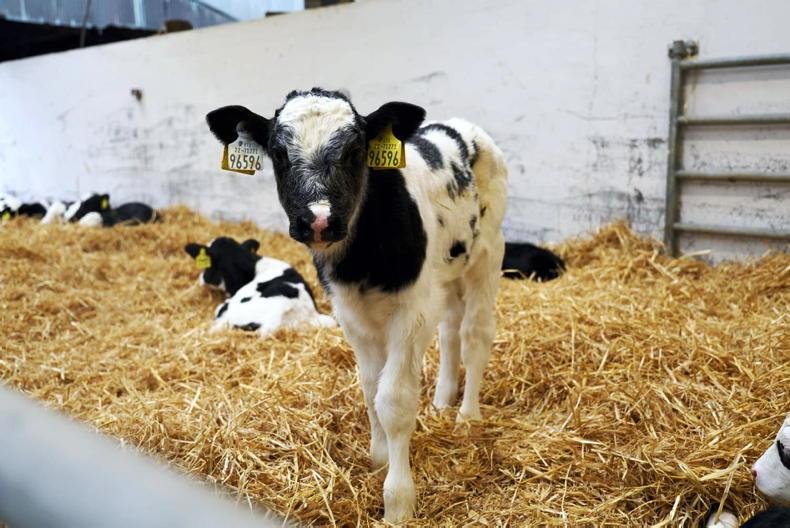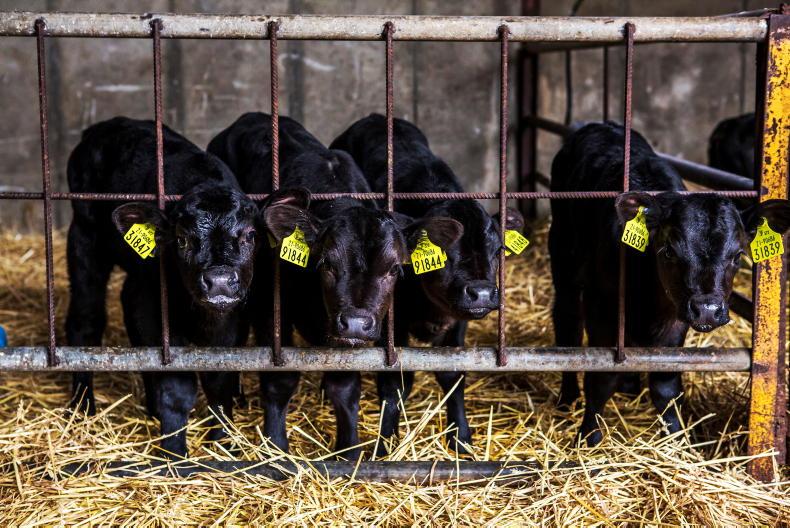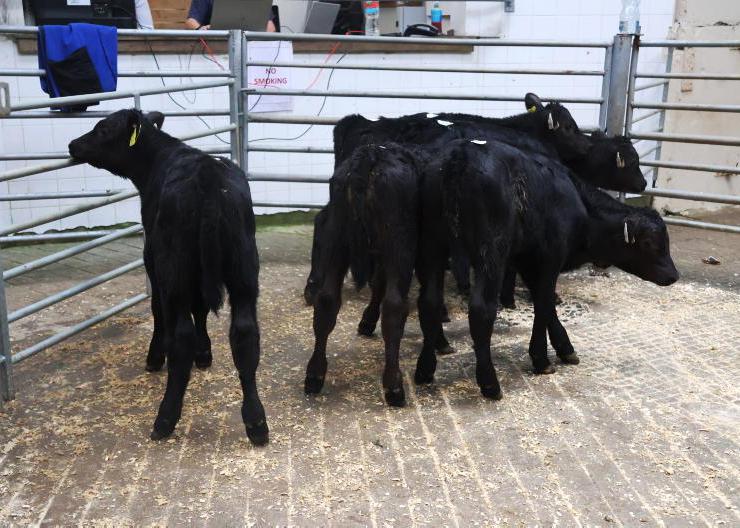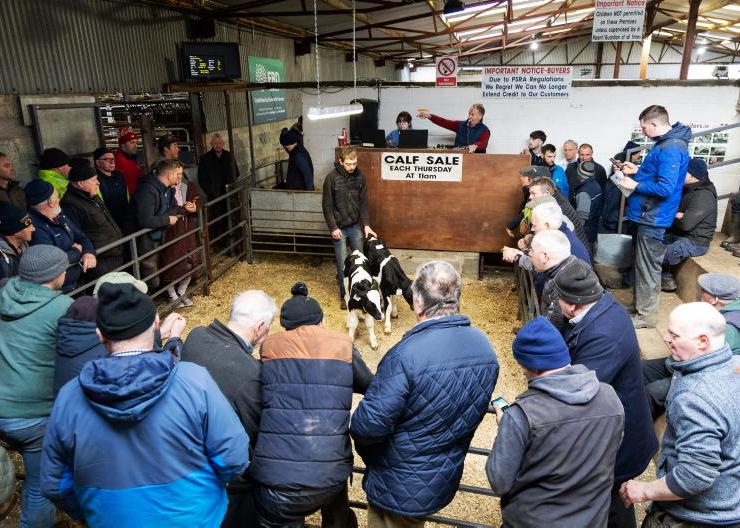Rearing dairy calves through to slaughter has become a common feature on many beef farms, either as the sole farming enterprise or operating alongside an established cattle or sheep system.
But like all aspects of farming, there are calf to beef units which are managed to an extremely high standard and return a good profit margin annually.
On the flip side, under poor management or when poor-quality calves are purchased, there can be significant losses incurred each year.
The period of peak buying for dairy-bred calves usually runs from late autumn to early spring, although with a flat calving profile on dairy farms, calves are available all year round.
Where farmers are currently on the market for dairy calves, outlined are 10 tips to rearing animals through to weaning stage.
Sourcing calves
When buying calves, the options are sourcing directly from the farm, through a cattle agent, or buying in person through the mart.
There are also farmers specialising in buying young calves, rearing them to weaning stage around 12 weeks old, then selling on for grazing and finishing.
Buying healthy calves is critical to making a profit. Farmers that excel at rearing dairy calves tend to do the buying themselves.
Also, they tend to confine buying to a handful of marts so that they have a better handle on the farmers selling calves and the background to calf quality and disease risks.
Purchase calves over a short period
Farmers that successfully rear dairy calves to beef will concentrate on buying a new intake of animals over the shortest possible time.
This allows calves to settle in the shed and once the initial stress period passes, the risk of disease starts to reduce.
In contrast, buying a handful of calves every week means there is a new disease challenge coming on-farm on a weekly basis, putting the new arrivals and animals already in the herd at risk.
Calf type, age and weight
targets
The type of calf offered for sale will include beef-sired heifers, as the vast majority of pure dairy female calves are retained for breeding.
On the male front, there will be the choice of beef cross or pure dairy calves. Montbéliarde and Fleckvieh bull calves offer greater beefing potential over Holsteins.
Calves should always be alert with clear eyes, walking freely, have no visible signs of a respiratory problem and have a shine to their coat.
Calves should be no younger than two weeks old when purchased. Many farmers will look for calves around four weeks old with a liveweight of 50kg to 60kg.
At the outlined age, mart prices are currently running from £150 to £300 for calves with native beef breeding, with Angus costing more than Hereford.
Continental beef calves will range from £250 to £350, depending on quality. Older calves approaching weaning, or already off milk, should weigh in excess of 120kg liveweight and can cost upwards on £500, depending on quality.
Know your market before
buying calves
Don’t head to the mart to buy calves without knowing what your end market will be.
Equally, don’t set out to buy cheaper calves thinking that because they cost less, there is more room to play with on rearing costs.
If the plan is to finish male calves as bulls, November and December 2022-born animals will be ready for slaughter by May/June 2024.
The downside to this is that the majority of the calf’s weight gain will come indoors from concentrate and forage.
These animals will be competing with spring-born continental bulls and spring-born continental steers, and negotiating with factory agents on price can be a challenge.
With late autumn-born heifers, there is the potential to finish these animals off grass after their second grazing season.
Beef-sired steers also allow for a greater percentage of liveweight to be gained at grass and with Angus breeding, animals will qualify for premiums when slaughtered.
Managing the calf on arrival
When newly purchased calves arrive on-farm, unload into straw-bedded pens with good ventilation and ideally in a separate airspace from other calves.
Offer fresh hay/straw, rather than silage, along with some concentrate. Keep a close eye on calves coming forward to feed when offered milk.
Calves that are slow to feed will be in the early stages of an illness. Check body temperature and treat accordingly.
Lying space is critical
Some farmers will use an anti-inflammatory as calves are unloaded, but will hold off on respiratory vaccines for 24 to 48 hours, as the animal’s immune system is likely to be suppressed and a vaccine could trigger pneumonia.
Once settled, calves can be vaccinated, dehorned if necessary, then moved to larger group pens.
Grouping calves
When it comes to grouping calves, there is a limit to how many animals should be in each pen. Lying space is critical. You don’t want to be regrouping calves every week as they grow and become overstocked.
Therefore, base the group number on the weaning weight of each animal if they normally move to a different shed post-weaning. Allow around 2m2-2.5m2 of lying space per calf up to weaning stage.
Bedding
Calves will spend 80% of their time lying, so ensure they always have a warm, dry lying area. A wet bed is a haven for disease. It will also lower the calf’s core body temperature.
This means the calf is burning more energy to stay warm. If it struggles to regulate its body temperature, there is a greater chance of animals becoming sick.
Straw bedding should be topped up regularly. Wood chip can also be used to good effect.
Feeding milk
Use a good-quality milk powder with 25% crude protein on a dry matter basis.
Feed milk powder at a rate of 125g per litre of water.
For a four-week-old calf, start off with 3l-4l of milk daily, rising to a peak of 6l/day by seven weeks old.
Wean calves around 100kg to 120kg at 12 weeks of age
From nine weeks of age, start reducing milk back down to around 5l/day, with the aim of weaning the calf off milk at 12 weeks old.
This should see calves consuming around 30kg to 35kg of milk powder.
The target is to wean calves around 100kg to 120kg at 12 weeks of age, provided they are eating 1kg/day of concentrate.
Concentrate type
Calves tend to perform better on a coarse ration compared to a pellet, as it aids rumen development. Keep the ration clean by offering a fresh allocation daily.
As calves consume more concentrate, they will have a greater requirement for water.
Always ensure calves have access to roughage in the form of straw or good-quality hay.
Post-weaning
Once weaned, do not lose focus on these calves. Continue to offer concentrate at 1kg/day to 1.5kg/day plus straw. Gradually introduce a high dry matter silage if available.
When calves are weaned in spring, they can be slipped out to grass. Rotationally grazing calves is recommended.
This will keep high-quality grass in front of calves and can help to reduce worm exposure compared to set stocking systems.
Once grass quality starts to decline in late summer, introduce concentrate at 1kg/day to maintain performance through the latter stages of the grazing season.
Read more
Ireland currently meeting nitrogen reduction target
Thrive: dry conditions allow the last heavy covers to be grazed
Rearing dairy calves through to slaughter has become a common feature on many beef farms, either as the sole farming enterprise or operating alongside an established cattle or sheep system.
But like all aspects of farming, there are calf to beef units which are managed to an extremely high standard and return a good profit margin annually.
On the flip side, under poor management or when poor-quality calves are purchased, there can be significant losses incurred each year.
The period of peak buying for dairy-bred calves usually runs from late autumn to early spring, although with a flat calving profile on dairy farms, calves are available all year round.
Where farmers are currently on the market for dairy calves, outlined are 10 tips to rearing animals through to weaning stage.
Sourcing calves
When buying calves, the options are sourcing directly from the farm, through a cattle agent, or buying in person through the mart.
There are also farmers specialising in buying young calves, rearing them to weaning stage around 12 weeks old, then selling on for grazing and finishing.
Buying healthy calves is critical to making a profit. Farmers that excel at rearing dairy calves tend to do the buying themselves.
Also, they tend to confine buying to a handful of marts so that they have a better handle on the farmers selling calves and the background to calf quality and disease risks.
Purchase calves over a short period
Farmers that successfully rear dairy calves to beef will concentrate on buying a new intake of animals over the shortest possible time.
This allows calves to settle in the shed and once the initial stress period passes, the risk of disease starts to reduce.
In contrast, buying a handful of calves every week means there is a new disease challenge coming on-farm on a weekly basis, putting the new arrivals and animals already in the herd at risk.
Calf type, age and weight
targets
The type of calf offered for sale will include beef-sired heifers, as the vast majority of pure dairy female calves are retained for breeding.
On the male front, there will be the choice of beef cross or pure dairy calves. Montbéliarde and Fleckvieh bull calves offer greater beefing potential over Holsteins.
Calves should always be alert with clear eyes, walking freely, have no visible signs of a respiratory problem and have a shine to their coat.
Calves should be no younger than two weeks old when purchased. Many farmers will look for calves around four weeks old with a liveweight of 50kg to 60kg.
At the outlined age, mart prices are currently running from £150 to £300 for calves with native beef breeding, with Angus costing more than Hereford.
Continental beef calves will range from £250 to £350, depending on quality. Older calves approaching weaning, or already off milk, should weigh in excess of 120kg liveweight and can cost upwards on £500, depending on quality.
Know your market before
buying calves
Don’t head to the mart to buy calves without knowing what your end market will be.
Equally, don’t set out to buy cheaper calves thinking that because they cost less, there is more room to play with on rearing costs.
If the plan is to finish male calves as bulls, November and December 2022-born animals will be ready for slaughter by May/June 2024.
The downside to this is that the majority of the calf’s weight gain will come indoors from concentrate and forage.
These animals will be competing with spring-born continental bulls and spring-born continental steers, and negotiating with factory agents on price can be a challenge.
With late autumn-born heifers, there is the potential to finish these animals off grass after their second grazing season.
Beef-sired steers also allow for a greater percentage of liveweight to be gained at grass and with Angus breeding, animals will qualify for premiums when slaughtered.
Managing the calf on arrival
When newly purchased calves arrive on-farm, unload into straw-bedded pens with good ventilation and ideally in a separate airspace from other calves.
Offer fresh hay/straw, rather than silage, along with some concentrate. Keep a close eye on calves coming forward to feed when offered milk.
Calves that are slow to feed will be in the early stages of an illness. Check body temperature and treat accordingly.
Lying space is critical
Some farmers will use an anti-inflammatory as calves are unloaded, but will hold off on respiratory vaccines for 24 to 48 hours, as the animal’s immune system is likely to be suppressed and a vaccine could trigger pneumonia.
Once settled, calves can be vaccinated, dehorned if necessary, then moved to larger group pens.
Grouping calves
When it comes to grouping calves, there is a limit to how many animals should be in each pen. Lying space is critical. You don’t want to be regrouping calves every week as they grow and become overstocked.
Therefore, base the group number on the weaning weight of each animal if they normally move to a different shed post-weaning. Allow around 2m2-2.5m2 of lying space per calf up to weaning stage.
Bedding
Calves will spend 80% of their time lying, so ensure they always have a warm, dry lying area. A wet bed is a haven for disease. It will also lower the calf’s core body temperature.
This means the calf is burning more energy to stay warm. If it struggles to regulate its body temperature, there is a greater chance of animals becoming sick.
Straw bedding should be topped up regularly. Wood chip can also be used to good effect.
Feeding milk
Use a good-quality milk powder with 25% crude protein on a dry matter basis.
Feed milk powder at a rate of 125g per litre of water.
For a four-week-old calf, start off with 3l-4l of milk daily, rising to a peak of 6l/day by seven weeks old.
Wean calves around 100kg to 120kg at 12 weeks of age
From nine weeks of age, start reducing milk back down to around 5l/day, with the aim of weaning the calf off milk at 12 weeks old.
This should see calves consuming around 30kg to 35kg of milk powder.
The target is to wean calves around 100kg to 120kg at 12 weeks of age, provided they are eating 1kg/day of concentrate.
Concentrate type
Calves tend to perform better on a coarse ration compared to a pellet, as it aids rumen development. Keep the ration clean by offering a fresh allocation daily.
As calves consume more concentrate, they will have a greater requirement for water.
Always ensure calves have access to roughage in the form of straw or good-quality hay.
Post-weaning
Once weaned, do not lose focus on these calves. Continue to offer concentrate at 1kg/day to 1.5kg/day plus straw. Gradually introduce a high dry matter silage if available.
When calves are weaned in spring, they can be slipped out to grass. Rotationally grazing calves is recommended.
This will keep high-quality grass in front of calves and can help to reduce worm exposure compared to set stocking systems.
Once grass quality starts to decline in late summer, introduce concentrate at 1kg/day to maintain performance through the latter stages of the grazing season.
Read more
Ireland currently meeting nitrogen reduction target
Thrive: dry conditions allow the last heavy covers to be grazed










SHARING OPTIONS